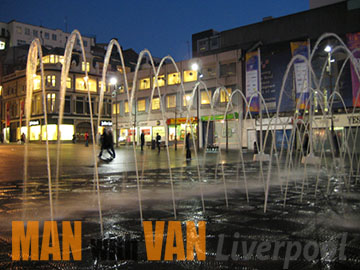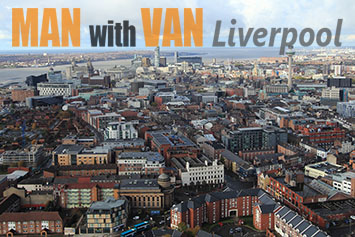The historical heart of Liverpool, its cultural, economic and commercial centre is of course the area that is defined as the Liverpool City Centre. It is a very interesting place indeed, one that is soaked in the spirit of the past centuries while the modern developments and attitudes are not overlooked even one bit. In many respects, those two otherwise opposing aspects co-exist in harmony here. The Liverpool City Centre is, in the opinion of many, the perfect example of a modern city, which is why it is worth it getting into some detail about its features and geography.
The unique parts
What makes the Liverpool City Centre different from the city centres of other big cities in Britain is the fact that there is no ring road that actually separates the heart from the rest of the metropolitan area. In contrast, the borders of the Liverpool City centre are defined by the borders of the districts of Vauxhall, Everton, Edge Hill, Kensington, and Toxteth. In the same vein, the postal districts that define the immediate centre of Liverpool are L1, L2 and L3. An interesting fact is that in recent years the amount of people moving in to live in the Liverpool City Centre are rising significantly, and today their number reaches 36 000.
A tourist attraction
 Liverpool received its first official status in 1207 and traces of the original settlements that the city consisted of are still to be seen in certain places in the City Centre. It is more than logical that the most interesting and popular tourist attractions in Merseyside are to found namely here, and the stats that are currently available show that this is exactly the case. According to the data, last year alone 650 000 people visited the Liverpool City Centre. The most famous site here is definitely the UNESCO World Heritage area that goes by the name of Liverpool Maritime City, which occupies the territories of the former imperial docks in the area.
Liverpool received its first official status in 1207 and traces of the original settlements that the city consisted of are still to be seen in certain places in the City Centre. It is more than logical that the most interesting and popular tourist attractions in Merseyside are to found namely here, and the stats that are currently available show that this is exactly the case. According to the data, last year alone 650 000 people visited the Liverpool City Centre. The most famous site here is definitely the UNESCO World Heritage area that goes by the name of Liverpool Maritime City, which occupies the territories of the former imperial docks in the area.
The areas
The Liverpool City Centre is divided into several key portions that make up for the different functions that the centre serves in the life and future of Liverpool. The key places here are as follows:
- Canning – the so called Georgian Quarter, which is one of the most chic residential areas in Liverpool at the present moment. Canning consists of several streets lined with old Georgian terraced houses which may very well be your dream home.
- The Cavern Quarter is around Matthew Street. There are many claims to fame for the Cavern Quarter, but the main one is definitely coming from the Cavern Club which gives its name to the whole area – that is the club where The Beatles played most of their concerts in the beginning of their career, which basically means this is the place where modern pop culture was shaped.
- The Central Retail Area on Church Street and Lord Street is where you are going to find the majority of the shops and fine restaurants in Central Liverpool. It is among the busiest places in the city and a very vibrant one for that matter too.
- Chinatown Every major city in the world seems to have its Chinatown, and there is nothing bad in it. Much like anywhere else, Liverpool’s Chinatown is very popular with tourists. It is also notable to say that with its 30 000 members of the Chinese ethnic minority group, it is the oldest Chinese community is Europe and the largest one outside of China.
 The Commercial District. London has The City and Canary Wharf, Liverpool has its commercial district. This is the place where you are going to find the tallest buildings and the biggest cluster of office space in Merseyside. Just some of the companies and organizations that have their headquarters in the Liverpool Commercial district include the Post & Echo, Unisys, HM Passport Office, BT and Maersk Line. The highest building here is the West Tower, which is raised at 140 meters, followed by the 90 m. Beetham Tower, the 86 m. Unity Residential, and the 76 m. New Hall Place, which by the way has the most extensive office floor place in Liverpool, at 35 000 sq meters at the present moment, all of which is occupied.
The Commercial District. London has The City and Canary Wharf, Liverpool has its commercial district. This is the place where you are going to find the tallest buildings and the biggest cluster of office space in Merseyside. Just some of the companies and organizations that have their headquarters in the Liverpool Commercial district include the Post & Echo, Unisys, HM Passport Office, BT and Maersk Line. The highest building here is the West Tower, which is raised at 140 meters, followed by the 90 m. Beetham Tower, the 86 m. Unity Residential, and the 76 m. New Hall Place, which by the way has the most extensive office floor place in Liverpool, at 35 000 sq meters at the present moment, all of which is occupied.- The so called Cultural Quarter is centered around the William Brown Street, next to St John’s Garden and the St George’s Hall. It is very near Lime Street Station too. The William Brown Street is relatively short, pedestrian street which contains most of Liverpool’s noticeable museums, libraries and galleries. The Nelson Column, a popular Liverpool Landmark, is also to be found here, standing right in front of the 1891 Country Sessions House and the Walker Art Gallery and Picton Reading Room.
- Liverpool Cathedral and Liverpool Metropolitan Cathedral are connected via Hope Street which is in its own right considered to be a very popular separate area in Liverpool’s city centre. The street is often flocked by students, which is easily explained by the fact that the University of Liverpool’s main campus is to be found here.
- The Waterfront is another place that deserves attention for the simple fact that the history of Liverpool is tightly connected to the maritime trade and exploration. There are three main subparts of the Waterfront – Kings Dock, Pier Head & Mann Island and Princes Dock. Most of the area has been recently redeveloped and accommodates several thousand new residents, on top of containing a number of rather popular tourist attractions.
Cultural hub
Liverpool’s culture is on its best display in the central parts of the city, which was by the way declared the European Capital of Culture for 2008. Mathew Street Music Festival is one of the most famous local annual events. National Museums Liverpool, World Museum Liverpool, William Brown Library and Museum and Walker Art Gallery and the Merseyside Maritime Museum, among others are great museums that you should definitely pay a visit to.